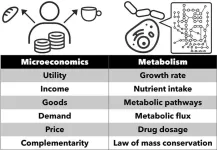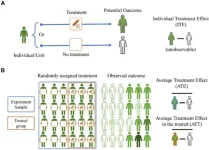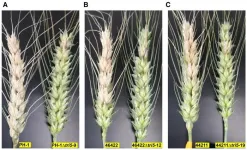The economic life of cells
Theory from microeconomics used to predict how biological systems respond to environmental change
2023-07-13
(Press-News.org)
A team from the University of Tokyo has combined economic theory with biology to understand how natural systems respond to change. The researchers noticed a similarity between consumers’ shopping behavior and the behavior of metabolic systems, which convert food into energy in our bodies. The team focused on predicting how different metabolic systems might respond to environmental change by using an economic tool called the Slutsky equation. Their calculations indicated that very different metabolic systems actually share previously unknown universal properties, and can be understood using tools from other academic fields. Metabolic processes are used in drug development, bioengineering, food production and other industries, so being able to predict how such systems will respond to change can offer many benefits.
Where do you get your energy from? Perhaps a long night’s sleep, or a good breakfast and some exercise? These activities can all help as they support a healthy metabolism, the chemical processes by which our bodies convert food and drink into energy. Understanding how individual metabolic reactions behave and predicting how they may change under different circumstances is a big challenge. There are thousands of different reactions which enable us to move, think, grow — in short, to live. In recent years, it has become possible to predict some reactions through numerical simulations, but this requires large amounts of data. However, researchers at the University of Tokyo have derived previously unknown universal properties of metabolic systems by applying microeconomic theory to their data.
“Until this research, we thought that metabolic systems varied so much among species and cell types that there were no common properties among them,” explained Assistant Professor Tetsuhiro Hatakeyama from the Graduate School of Arts and Sciences. “However, we were very excited to demonstrate that all metabolic systems have universal properties, and that these properties can be expressed by very simple laws.” According to the researchers, this theory does not require as much detailed background data to be collected as other methods. It can also be effectively applied whether you are trying to understand the behavior of all metabolic processes in a cell or focusing on just one part — say, for example, how much oxygen it is using.
Hatakeyama, a biophysicist, was looking at some metabolic system diagrams when he noticed a striking similarity to diagrams used in economics. This realization inspired him to try an interdisciplinary approach and apply economic theory, which he had briefly studied, to his biology research. Along with co-author Jumpei Yamagishi, a graduate student in the same lab, he decided to explore how both consumers and cells optimize their “spending” to maximize gain: Whereas we as consumers spend money, cells “spend” nutrients. They reasoned if there were similarities in this way, then perhaps the same theories that are used to identify patterns in consumer behavior under changing financial situations could also identify patterns in cellular metabolic behavior under changing environments.
More specifically, the researchers focused on the Slutsky equation, which is used to understand changes in consumer demand. In particular, it is used to understand so-called Giffen goods, which counterintuitively go up in demand when the price increases and go down in demand when the price decreases. According to Hatakeyama, this is similar to cellular metabolic behavior in response to a disturbance. For example, respiration demand (the Giffen goods in this case) in cancer cells goes up, counterintuitively, with increased drug dosage (the “price”), even though this is not beneficial to the growth rate of the cancer. The outcome was that the team uncovered a universal law for how metabolic systems respond to change.
One of the key benefits of this law is that it can be used to understand metabolic systems about which few details are known. “Disturbances in metabolic systems lead to a variety of diseases, and our research could be used to propose new treatment strategies for diseases for which treatments are not fully understood,” said Hatakeyama. “In addition, many foods and medicines are made using the metabolic systems of organisms. By applying the simple equation found in this study, we can know how to increase the output of products made with these systems.” Hatakeyama hopes that through further interdisciplinary research, more universal laws might be discovered that will lead to a variety of useful applications.
########
Paper Title:
Jumpei F. Yamagishi and Tetsuhiro S. Hatakeyama. Linear Response Theory of Evolved Metabolic Systems. Physical Review Letters.
Funding
This research was partially supported by JSPS KAKENHI Grant Numbers JP21J22920 and JP21K15048 and the Masason Foundation.
Useful Links
Graduate School of Arts and Sciences: https://www.c.u-tokyo.ac.jp/eng_site/
Research Contact:
Assistant Professor Tetsuhiro S. Hatakeyama
Department of Basic Science
Graduate School of Arts and Sciences
The University of Tokyo
3-8-1 Komaba, Meguro-ku, Tokyo 153-8902, Japan
Email: hatakeyama@complex.c.u-tokyo.ac.jp
Tel.: +81-3-5454-6731
Press contact:
Mrs. Nicola Burghall
Public Relations Group, The University of Tokyo,
7-3-1 Hongo, Bunkyo-ku, Tokyo 113-8654, Japan
press-releases.adm@gs.mail.u-tokyo.ac.jp
About the University of Tokyo
The University of Tokyo is Japan's leading university and one of the world's top research universities. The vast research output of some 6,000 researchers is published in the world's top journals across the arts and sciences. Our vibrant student body of around 15,000 undergraduate and 15,000 graduate students includes over 4,000 international students. Find out more at www.u-tokyo.ac.jp/en/ or follow us on Twitter at @UTokyo_News_en.
END
[Attachments] See images for this press release:

ELSE PRESS RELEASES FROM THIS DATE:
2023-07-13
Manganese-rich NASICON-type materials have attracted widespread attention for developing advanced polyanionic cathodes, primarily driven by their abundant reserves, promising cycling performance, and potentially high operating voltage.
Unfortunately, their charge/discharge profiles exhibit significant voltage hysteresis, which leads to a limited reversible capacity, thereby preventing their application.
Now, however, the situation may be changing due to research by scientists at the Institute of Process Engineering (IPE) and the Institute of Physics of the Chinese Academy of Sciences. They recently identified ...
2023-07-13
Clean energy plans, including the U.S. Infrastructure Investment Act’s “Clean Hydrogen Road Map,” are counting on hydrogen as a fuel of the future. But current hydrogen separation technology is still falling short of efficiency and sustainability goals. As part of ongoing efforts to develop materials that could enable alternative energy sources, researchers in Drexel University’s College of Engineering have produced a titanium oxide nanofilament material that can harness sunlight to unlock the ubiquitous molecule’s potential as a fuel source.
The discovery offers an alternative ...
2023-07-13
A Perspective published in Volume 3 of the journal Psychoradiology, researchers from Shanghai Jiao Tong University confronted these challenges and advocates for more clarity and transparency in causal analyses. The review distinguishes between traditional statistical analysis and causal inference, highlighting the need for specific causal assumptions, like the Stable Unit Treatment Value Assumption (SUTVA).
Randomized controlled trials (RCTs) are considered the gold standard for estimating causal effects. The authors stress the importance of imitating RCTs in observational studies through quasi-experimental techniques, ...
2023-07-13
Gero, an AI-driven biotech focused on aging and longevity, has demonstrated the feasibility of applying quantum computing for drug design and generative chemistry, which now offers significant promise for the future of healthcare. The research, published in Scientific Reports, outlines how a hybrid quantum-classical machine-learning model was used to interface between classical and quantum computational devices with the goal of generating novel chemical structures for potential drugs — an industry first.
The research paper follows ...
2023-07-13
A new study suggests eastern wild turkeys in five southern U.S. states are unlikely to make meaningful changes in the timing of when they begin nesting, even under significant future climate change.
The findings suggest eastern wild turkeys (Meleagris gallopavo silvestris) could be vulnerable to shifts in climate, which could threaten the availability of their food sources, the amount of vegetation cover available to protect them from predators, and other factors.
“There are implications here for turkey populations ...
2023-07-13
Although wheat was among the first domesticated food crops, it remains a global dietary staple several millennia later. Grown on every continent except Antarctica, wheat is the second highest produced grain worldwide, with nearly 800,000 metric tons grown each year (Food and Agriculture Organization). However, a fungal pathogen named Fusarium graminearum causes the devastating disease Fusarium head blight (FHB) on wheat and contaminates grains with harmful toxins called trichothecenes. One such trichothecene, called deoxynivalenol (DON), is produced by most F. graminearum strains in the United States, and it is an essential virulence factor that increases the pathogen’s spread ...
2023-07-13
Currently, there is no cure for amyloidosis, a life-threatening disease that can be present throughout the body, including the heart, kidneys, liver and brain. The most common localized form of amyloidosis, which is seen significantly more often, is in the brain. Cerebral amyloidosis, when symptomatic, usually manifests in one of two ways: in Alzheimer’s disease and related dementias and in brain bleeds, which have consequences such as a stroke.
Because amyloidosis does not affect a specific organ, unraveling the underlying cause of amyloid fibril creation – a hallmark ...
2023-07-13
SAN FRANCISCO—Schmidt Marine Technology Partners, a program of the Schmidt Family Foundation, has awarded $3.5 million in grants to ten organizations and universities in seven countries for the development of new tools and innovations that will improve the sustainability of global fisheries, the program announced today.
“Tens of millions of jobs around the world depend on fisheries, and seafood is the primary protein source for 3 billion people,” said Wendy Schmidt, president and co-founder of the Schmidt Family Foundation. “The innovators chosen to receive these grants are ensuring that fishers and ...
2023-07-13
A University of Minnesota Twin Cities team has, for the first time, synthesized a thin film of a unique topological semimetal material that has the potential to generate more computing power and memory storage while using significantly less energy. The researchers were also able to closely study the material, leading to some important findings about the physics behind its unique properties.
The study is published in Nature Communications, a peer-reviewed scientific journal that covers the natural sciences and engineering.
As evidenced by the United States’ recent CHIPS and Science Act, there is a growing need to increase semiconductor manufacturing ...
2023-07-13
Researchers at University of Michigan developed a method to produce artificially grown miniature brains — called human brain organoids — free of animal cells that could greatly improve the way neurodegenerative conditions are studied and, eventually, treated.
Over the last decade of researching neurologic diseases, scientists have explored the use of human brain organoids as an alternative to mouse models. These self-assembled, 3D tissues derived from embryonic or pluripotent stem cells ...
LAST 30 PRESS RELEASES:
[Press-News.org] The economic life of cells
Theory from microeconomics used to predict how biological systems respond to environmental change






